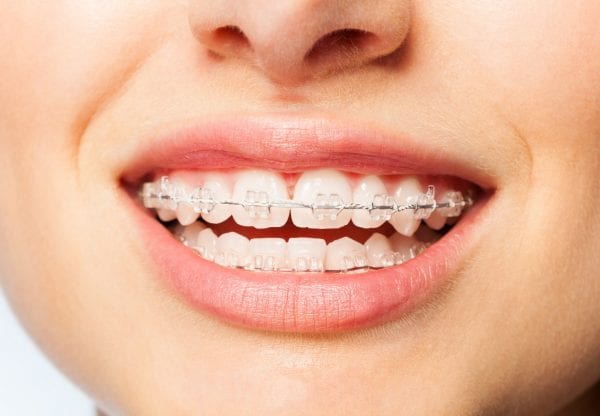How Archwires Function in Orthodontic Treatment
 Orthodontic braces are made up of different parts. Each part performs a function that helps the orthodontist bring about a beautiful smile by the end of treatment.
Orthodontic braces are made up of different parts. Each part performs a function that helps the orthodontist bring about a beautiful smile by the end of treatment.
While brackets and elastics play important roles, the wiring is the part of the system that is essential in bringing the teeth together in perfectly straight rows.
Also known as the archwire, this part of the braces system is the thin wire that passes through each individual bracket (brace). It is held securely in place by the tiny elastic ties or clasps on each bracket.
When braces are initially placed and teeth are crooked and irregular, the archwire needs to be flexible so that they can be placed comfortably and without too much force. Modern orthodontic wires have “shape memory,” meaning they can return to their normal shape while in the mouth. This force, in turn, causes the teeth to move as well.
As the teeth begin to align, the orthodontist will periodically change these very flexible shape memory wires for others that are more resilient and rigid. A stiffer archwire allows for more precise control over specific tooth movements. This is when fine detailing of each tooth position may be implemented.
Do You Need Orthodontic Treatment?
As board-certified orthodontists, Dr. Redford and Dr. Burke excel at every aspect of orthodontic care. Delivering the best patient experience is a top priority at Burke & Redford Orthodontists, which is the highest-rated orthodontic practice in Temecula and Lake Elsinore.
Please call (951) 699-8011 to schedule a free consultation with our doctors during our business hours.
What Does an Archwire Do?
 The central function of the archwire is to shift the teeth into their proper positions. It is responsible for most movements that occur in the mouth during treatment.
The central function of the archwire is to shift the teeth into their proper positions. It is responsible for most movements that occur in the mouth during treatment.
Throughout the duration of a patient’s treatment, the use of constant yet gentle force on the teeth and brackets by this wiring mechanism works to bring each tooth into its intended place.
One of the goals of the orthodontist is to move teeth not only gently, but also efficiently. Each patient is unique and how quickly their teeth respond to the gentle forces is variable. The time spent in treatment may be shortened or extended depending on how much total movement is needed and how the person’s teeth respond on an individual basis.
It is for good reason that the teeth must be guided slowly and gradually into place. This not only allows for increased comfort for the patient, but it ensures that the roots of the teeth and the surrounding bone and gum tissue are treated safely.
How Does it Make My Teeth Move?
A soft tissue known as the periodontal ligament connects and anchors each tooth to the surrounding bone. When pressure is applied this malleable tissue stretches and moves. In turn, it communicates with the surrounding bone, signaling it to remodel and allow for movement of teeth.
When braces are fixed to the teeth and gentle force is applied through archwires, this periodontal ligament-bone-tooth complex reorganizes and allows for movement to occur.
Main Types of Archwire
It is important to briefly go over the different types of archwire options used in conjunction with braces. Orthodontic archwire is normally made from alloy material. This material allows the wire to maintain ample elasticity and durability as it works to apply the necessary force on the mouth during treatment.
Listed below are the 4 main types of wires used in orthodontic treatment:
- Stainless-steel alloy
Despite the popularity of newer types, the stainless-steel option is not only durable and corrosion-resistant, but it is very stable.
- Nickel-titanium alloy
This type of wire employs shape-memory technology that allows it to return to its original form, no matter how many times it is bent into various shapes. This is the material used for the first two or three wires when teeth are most crooked.
- Beta-titanium alloy
This wire type is easy to bend and shape. It is often used as the final wire when the orthodontist is placing small detail bends into the wire to fine tune the final position of teeth.
- Cobalt-chromium alloy
This variation of alloy offers the feature of being able to adjust its form and the level of its strength as needed. This is accomplished by exposing it to heat treatment, which can reinforce and reshape the wire. It is used less often nowadays.
Common Terms Associated with the Archwire
Listed below are some common terms that may come up when discussing these types of wires.
- Springback: This refers to a wire’s capability of being shaped in different ways while still going back to its original form, if needed.
- Resilience: The amount of elasticity within a wire.
- Formability: The maximum amount of bend a wire may undergo before breaking.
- Shape memory alloy: Some wires have the capability of going back to their original shape despite being distorted.
- Failure point: The breaking point of a wire.
- Range: The maximum extent to which wiring may be bent before it permanently loses its original shape.
While these terms and the material science behind archwire technology is not something many patients think about, our experienced doctors consider these properties when treatment planning a case and selecting the right types of wires to be successful.
How Can I Begin Treatment?
 At Burke & Redford Orthodontists, our doctors have undergone the extensive training and experience necessary to become the most highly sought-out doctors in the area.
At Burke & Redford Orthodontists, our doctors have undergone the extensive training and experience necessary to become the most highly sought-out doctors in the area.
Our doctors offer top-of-the-line technology and service to patients of every age group.
We offer the following types of braces:
- Invisalign clear aligners
- Ceramic self-ligating braces
- Metal self-ligating braces
- Damon braces system (a brand of self-ligating braces)
We are constantly scouring the market for the latest technology in orthodontic materials to best serve our patients. We use the newest and best materials available to achieve outstanding results. That said, it is important to remember that the orthodontic braces and archwires used during treatment are simply a tool. The results obtained during treatment are a direct result of the expertise of the doctor and staff with these tools at their disposal.
Our practice offers all new patients a free consultation with our doctors to discuss a patient’s current orthodontic issues and the detailed plans of treatment going forward.
This consultation is an excellent opportunity to get to know our doctors and discuss any of your concerns or questions.
They will work with you to decide upon a treatment plan that is safe, comfortable, and perfectly planned to fit your needs.
After agreeing on a treatment plan, one of our treatment coordinators will go over the financial investment and available financing options. We strive to make treatment affordable for all.
If you are ready to take the first steps in achieving a beautiful smile and want to learn more about the archwire and braces or Invis options, please call Burke & Redford Orthodontists at (951) 699-8011. Our offices are in Lake Elsinore and Temecula.